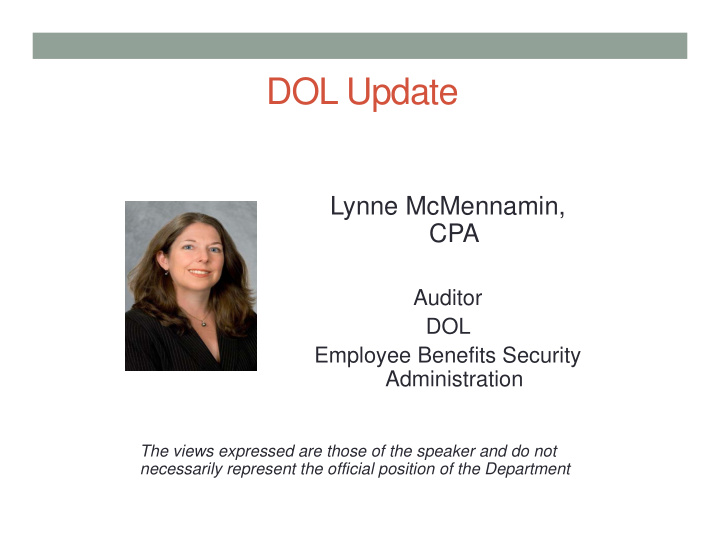



DOL Update Lynne McMennamin, CPA Auditor DOL Employee Benefits Security Administration The views expressed are those of the speaker and do not necessarily represent the official position of the Department
2 Overview EBSA Audit Quality Study • New Initiatives • Enforcement Initiatives • On the Horizon – Emerging Issues • DOL Resources • 2
3 Audit Quality Study
4 Statistical Sample of 400 Plan Audits • 2011 Form 5500 filings • 6 strata based on size of EBP practice • 1-2 plans • 3-5 plans • 6-24 plans • 25-99 plans • 100-749 plans • 750 + plans • 1 audit in lowest 2 strata, 5 in all others 4
5 Our Sample • Type of Audit • 80% = Limited Scope • 19% = Full Scope • 1% = Other • Plan Type • 89% = DC Pension Plan • 6% = DB Pension Plan • 5% = Welfare Plan 5
6 Our Sample • Sponsor Type • 95% = Single Employer • 3% = Multi-Employer • 2% = Multiple Employer • EBPAQC Member • 55% = Yes • 45% = No 6
7 Findings
8 Size of EBP Practice Matters • Correlation between a firm’s EBP practice and deficient work • Nearly 75% of plan audits were deficient in firms who audit 1-2 plans annually • Deficient audits in this strata also had many more deficiencies • 75% of deficient plan in audits in the 1-2 strata had deficient audit work in 5 or more areas • Uniformly higher deficient work in all audit areas • Less EBP specific training by firms in this strata 8
9 Practice Monitoring/Peer Review are not Useful Identifiers of Quality EBP Audits • Over 90% of firms in 6-99 strata who performed deficient EBP audits received clean peer review reports • In 4 of 6 strata, firms had clean peer review reports where we identified deficient EBP audit work • Nearly 70% in 1-2 strata • 85% in the 3-5 strata • In 4 of 6 strata, audits with 5+ deficiencies were performed by firms with clean peer review reports 9
10 Other Useful Findings • No meaningful correlation between audit fees and the quality of audit work • EBPAQC member firms performed higher quality work than non member firms • Audit work is often of lesser quality in engagements where firms have less expertise • Problematic audit areas continue to be the same EBP-specific areas as previously identified 10
11 Referrals of Deficient Audit Work • 131 referrals made to the AICPA’s Professional Ethics Division • 13 referrals made to state boards of public accountancy 11
12 What Is Our Current Focus? • High Risk Audit Engagements • Health and Welfare Plans • ESOPs • Plans with hard-to-value assets • Re-inspections of CPA firms • Continued Outreach to EBP Stakeholders 12
13 New Initiatives
14 Peer Review • Are CPAs complying with state peer review licensing requirements? • Practitioners in states with peer review requirement • Provide evidence that an acceptable peer review was performed 14
15 Peer Review • CPAs performing audits (in the Form 5500 database) –that are not in the AICPA’s peer review records • AICPA has found numerous CPAs performing attest engagements that have not been enrolled in the peer review program 15
16 Licensure • Are firms properly licensed where they practice? • Rules vary by state • NASBA website – auditor mobility • NASBA provided list of plan auditors to states • States reviewing to see if CPAs are properly licensed 16
17 Enforcement Initiatives
18 Reporting Compliance Enforcement • Reporting of fidelity bonding status • Missing audit reports • Compliance with Small Pension Plan Audit Waiver requirements 18
19 Reporting Compliance Enforcement • DFVC program compliance • Plan asset accountability • Health & welfare plan non-filers • Stop filers (cooperative initiative with IRS) 19
20 Health & Welfare Benefit Plans • Benefit claims adjudication/payments is very complex and there is inherently a high risk of errors, misstatements or fraud. Plan accordingly. • Must be paid in the correct amount timely, in accordance with plan documents • Only to or on behalf of eligible, covered persons entitled to receive benefits 20
21 Health & Welfare Benefit Plans • Properly recorded and described in plan financial statements • Type 2 SOC 1 reports may not include controls over whether the claim or benefit payment was appropriately calculated based on the provisions of the plan instrument. 21
22 On the Horizon – Emerging Issues • New Actuarial Study Longevity Improvements Considerations • FASB Simplification Project • Auditing Standards Board Project to Improve Plan Audit Reports • EFAST 3 and Form 5500 Changes • New AICPA Audit Quality Center Tools 22
23 DOL Resources • www.dol.gov/ebsa • For DOL publications, FAQs, copies of the Form 5500, instructions, and related schedules • EBSA Office of the Chief Accountant 202-693-8360 • EBSA Office of Regulations and Interpretations 202-693-8500 • For questions about ERISA reporting, filing or other regulatory requirements • DOL EFAST Help Center 1-866-463-3278 • For questions regarding the Form 5500 or related schedules 23
Recommend
More recommend